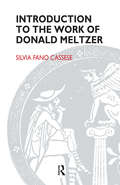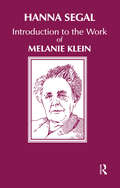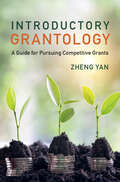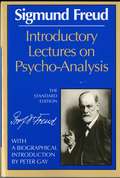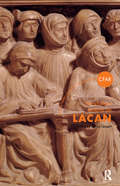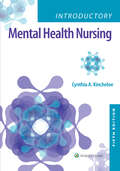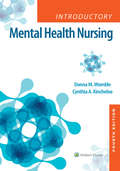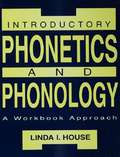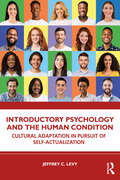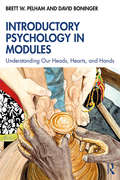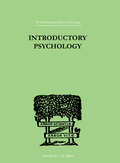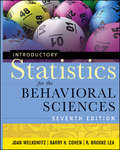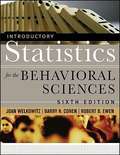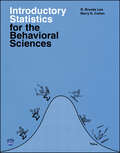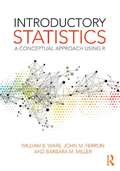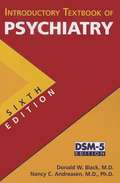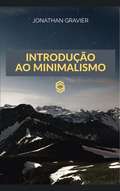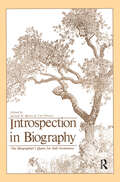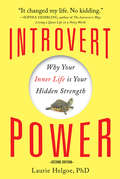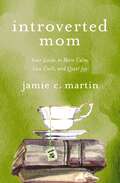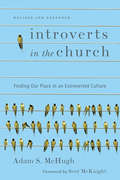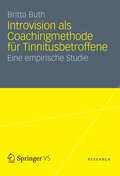- Table View
- List View
Introduction to the Theories of Measurement and Meaningfulness and the Use of Symmetry in Science (Scientific Psychology Ser.)
by Louis NarensThis book is designed to be an introduction to the theories of measurement and meaningfulness, and not a comprehensive study of those topics. A major theme of this book is the psychophysical measurement of subjective intensity. This has been a subject of intense interest in psychology from the very beginning of experimental psychology. And from tha
Introduction to the Work of Donald Meltzer
by Silvia Fano CasseseIntroduction to the Work of Donald Meltzer is a critical survey of Donald Meltzer's central themes which simultaneously focuses on the most important concepts of his work. This detailed volume should not only spark the reader's interest in these fascinating, yet complex, themes but also encourage readers to deepen their knowledge of them. 'I have tried to point out an aspect which, in my view, is fundamental in Meltzer's theory: that is, the possibility of communicating those typical aspects of his analytical work which go beyond the well-established and reassuring technique. Meltzer's interest constantly turns to that area which is difficult to describe in words and perhaps cannot be expressed in conventional language: the emotional area of non-verbal communication, of reverie and unconscious thinking.'- From the Preface
Introduction to the Work of Melanie Klein (Maresfield Library)
by Hanna SegalA most lucid and comprehensive introduction to Kleinian theories from one of the leading contemporary Kleinian analysts, including new chapters on her early work and on technique. This is a reprint of a revised and enlarged edition, where the author has added important new chapters on Melanie Klein's early work and on technique, as well as a complete chronological list of her publications.
Introductory Grantology: A Guide for Pursuing Competitive Grants
by Zheng YanThis book addresses the lack of systematic training in journal publication and grant pursuit for new scholars, two key skills in today's academic landscape. It introduces 'grantology,' the science of pursuing grants, providing practical, evidence-based strategies. Structured like a graduate course, each chapter follows a five-step cognitive sequence based on Daniel Kahneman's intuitive judgment theory. The book explores over fifty real-life cases, draws from nearly two hundred research articles, and compares grantology with journalology. With scientific insights and actionable advice, this guide supports junior researchers, graduate students, and new grant writers in developing the skills needed to pursue competitive grants and advance their careers.
Introductory Lectures On Psycho-Analysis
by Sigmund Freud Translated edited by James StracheyFreud approved the overall editorial plan, specific renderings of key words and phrases, and the addition of valuable notes, from bibliographical and explanatory. <P><P>Many of the translations were done by Strachey himself; the rest were prepared under his supervision. The result was to place the Standard Edition in a position of unquestioned supremacy over all other existing versions.
Introductory Lectures on Lacan (The Centre for Freudian Analysis and Research Library (CFAR))
by Astrid GessertLacan developed his theory and practice of psychoanalysis on the basis of Freud's original work. In his "return to Freud" he not only elaborated and revised some of Freud's innovative ideas, but turned to important questions and problems in Freud's theory that had remained obscure and unresolved, and provided a new way of articulating these issues and their implication for psychoanalytic theory and practice. This book offers a selection of chapters about some of the fundamental concepts of psychoanalysis. The authors aim to explore the trajectory of the development of these concepts from their original basis in Freud's work to their elaboration by Lacan. The book will be of interest to readers from different backgrounds, including the clinical and academic field, social and cultural studies and the arts, for whom psychoanalytic ideas may be a relatively new field to explore, or who are looking for new perspectives to develop their ideas about psychoanalysis.
Introductory Mental Health Nursing
by Cynthia A. KincheloeUpdated, easy to read, and designed specifically for today’s LPN/LVN students, Introductory Mental Health Nursing, 5th Edition, makes the realities of mental health nursing approachable and prepares students to confidently manage clients’ mental healthcare needs across a wide range of care settings. This extensively revised 5th Edition delivers clear, comprehensive, clinically relevant information reflecting the care needs of a diverse client population. Powerful built-in study aids strengthen students’ critical thinking and clinical application capabilities to prepare them for any challenge they may encounter.
Introductory Mental Health Nursing
by Cynthia Kincheloe Donna WomblePublisher's Note: Products purchased from 3rd Party sellers are not guaranteed by the Publisher for quality, authenticity, or access to any online entitlements included with the product. Introductory Mental Health Nursing, 4th Edition Donna Womble, MEd, BS, RN; and Cynthia A. Kincheloe, MSN, BSN, ADN, RN Confidently manage the mental health issues you’ll encounter across a wide range of health care settings. Written specifically for LPN/LVN students, Introductory Mental Health Nursing, 4th Edition, equips you for the challenges of modern mental health nursing with clear, direct, clinically relevant information reflecting the most up-to-date perspectives in the field. This acclaimed text establishes essential groundwork then builds on fundamental concepts to instill a confident understanding of the delivery of mental health care, the nursing process and its relation to mental health, and the management of specific psychiatric disorders to prepare you for success from the classroom to your career. Enhanced! Case applications guide you in applying the nursing process to resolve clinical problems. Updated! Chapter-ending Student Worksheets reinforce key concepts through fill-in-the-blank, matching, and multiple-choice NCLEX®-style questions. At a Glance sections highlight or summarize essential information for stronger recall and retention. Just the Factsentries distill critical details for faster, more efficient review. Mind Jogger critical thinking questions promote deeper understanding. At-A-Glance Senior Focus helps you confidently prepare for the care of older adults or elderly clients. Updated terminology helps you ensure the most effective clinical communication.
Introductory Phonetics and Phonology: A Workbook Approach
by Linda I. HouseSuccess in mastering any language requires knowledge in speaking, reading, and writing the language. The speaking component requires the understanding and use of correct pronunciation, emphasis, and syntactic patterns. The written component requires mastery of the alphabet, spelling, and the ability to write, print, or type the pattern. Very early in the learning process, speakers of the English language become keenly aware of the language's lack of sound to symbol correspondence. To help speech/language researchers, media personnel, individuals learning English as a second language, and others interested in correct pronunciation, the International Phonetic Alphabet (IPA) was devised. Extensively class tested, this book offers a practical understanding approach to phonetics and the IPA in a workbook format. It will be welcomed by professionals, students, and trainees in the fields of communication science, communication disorders, speech pathology, and linguistics.
Introductory Psychology and the Human Condition: Cultural Adaptation in Pursuit of Self-Actualization
by Jeffrey C. LevyIntroductory Psychology and the Human Condition provides an engaging, cohesive, and practical treatment of traditional psychological principles and theories.The book uses Maslow’s human needs hierarchy and Bronfenbrenner’s ecological theory of development as organizational schemas for considering how cultures have evolved to address human needs. It relates major psychological processes, including biology, perception, motivation, learning, and cognition, to lifespan and personality development in nomadic hunter-gatherer and technologically enhanced cultures. Human history is described as a feedback loop in which inventions and technologies result in the need for individuals and cultures to adapt to changing environmental and social conditions. By applying interdisciplinary perspectives of the humanities, social and natural sciences, and helping professions to the human condition, it offers a meaningful lens through which to study and interpret core psychological concepts. Chapters are supported by self-understanding and self-control exercises that help students place their lives within a cultural and historical context and apply the principles of psychology to themselves.Offering an engaging overview of the essential elements of an introductory psychology course in an accessible and approachable style, Introductory Psychology and the Human Condition is core reading for introductory students and will appeal also to a general audience interested in psychology.
Introductory Psychology in Modules: Understanding Our Heads, Hearts, and Hands
by Brett Pelham David BoningerIntroductory Psychology in Modules: Understanding Our Heads, Hearts, and Hands is a unique and comprehensive introduction to psychology. It consists of 36 short modules that keep students engaged with humor, a narrative style, and hands-on activities that facilitate interactive learning and critical thinking. Each stand-alone module focuses on a major topic in psychology, from the brain, sensation, memory, and cognition to human development, personality, social psychology, and clinical psychology. The modular format also allows a deep dive into important topics that have less coverage in other introductory psychology textbooks. This includes cross-cultural psychology, stereotypes and discrimination, evolutionary psychology, sex and gender, climate change, health psychology, and sport psychology. This truly modular format – ideal for both face to face and virtual learning – makes it easy for instructors to customize their readings and assign exactly what they wish to emphasize. The book also contains an abundance of pedagogical features, including numerous hands-on activities and/or group discussion activities, multiple-choice practice quizzes, and an instructor exam bank written by the authors. By covering both classic and contemporary topics, this book will delight students and instructors alike. The modular format also makes this a useful supplementary text for classes in nursing, medicine, social work, policing, and sociology.
Introductory Psychology: AN APPROACH FOR SOCIAL WORKERS (International Library Of Psychology Ser.)
by Price-Williams, D RFirst published in 1999. Routledge is an imprint of Taylor & Francis, an informa company.
Introductory Statistics for the Behavioral Sciences
by Barry H. Cohen R. Brooke Lea Joan WelkowitzA comprehensive and user-friendly introduction to statistics for behavioral science students-revised and updatedRefined over seven editions by master teachers, this book gives instructors and students alike clear examples and carefully crafted exercises to support the teaching and learning of statistics for both manipulating and consuming data.One of the most popular and respected statistics texts in the behavioral sciences, the Seventh Edition of Introductory Statistics for the Behavioral Sciences has been fully revised. The new edition presents all the topics students in the behavioral sciences need in a uniquely accessible and easy-to-understand format, aiding in the comprehension and implementation of the statistical analyses most commonly used in the behavioral sciences.The Seventh Edition features: A continuous narrative that clearly explains statistics while tracking a common data set throughout, making the concepts unintimidating and memorable, and providing a framework that connects all of the topics and allows for easy comparison of different statistical analyses Coverage of important aspects of research design throughout the text, such as the "correlation is not causality" principle Updated and annotated SPSS output at the end of each chapter with step-by-step instructions Updated examples and exercises An expanded website, at www.wiley.com/go/welkowitz, with test bank, chapter quizzes, and PowerPoint slides for instructors, as well as a second website for students with additional basic math coverage, math review exercises, a study guide, a set of additional SPSS exercises, and more downloadable data sets
Introductory Statistics for the Behavioral Sciences
by Barry H. Cohen Joan Welkowitz Robert B. EwenA comprehensive and user-friendly introduction to statistics-now revised and updatedIntroductory Statistics for the Behavioral Sciences has had a long and successful history and is a popular and well-respected statistics text. Now in its sixth edition, the text has been thoroughly revised to present all the topics students in the behavioral sciences need in a uniquely accessible format that aids in the comprehension and implementation of the statistical analyses most commonly used in the behavioral sciences.Using a continuous narrative that explains statistics and tracks a common data set throughout, the authors have developed an innovative approach that makes the material unintimidating and memorable, providing a framework that connects all of the topics in the text and allows for easy comparison of different statistical analyses.New features in this Sixth Edition include:* Different aspects of a common data set are used to illustrate the various statistical methods throughout the text, with an emphasis on drawing connections between seemingly disparate statistical procedures and formulas* Computer exercises based on the same large data set and relevant to that chapter's content. The data set can be analyzed by any available statistical software* New "Bridge to SPSS" sections at the end of each chapter explain, for those using this very popular statistical package, how to perform that chapter's statistical procedures by computer, and how to translate the output from SPSS* New chapters on multiple comparisons and repeated-measures ANOVA
Introductory Statistics for the Behavioral Sciences
by Barry H. Cohen R. Brooke LeaThe accessible, hands-on statistics textbook that behavioral science students and instructors trust Introductory Statistics for the Behavioral Sciences is a respected, practical textbook that offers carefully crafted exercises to support the teaching and learning of statistics. This revised eighth edition presents all the topics students in the behavioral sciences need in a uniquely accessible format, making statistics feel relevant and approachable. With fictitious yet realistic examples that reappear throughout the chapter, students can follow a continuous narrative that helps them engage with and internalize the content. User-friendly integration with SPSS software enables readers to gain hands-on experience with the application of theoretical concepts. Exercises at the end of each chapter, with additional practice in the online study guide, give students the repetition they need to fully comprehend the material. After working through this textbook, students will understand, not only the what, but also the why of statistical analysis. Get plain-English explanations of statistical concepts and procedures important in behavioral sciences research Learn from relatable examples and exercises focused on psychology, sociology, and other behavioral science Work through well-crafted exercises designed to enhance your understanding of the material Get clear instructions on how to perform statistical procedures with the industry-standard SPSS software Online resources for instructors include a test bank, chapter quizzes, and PowerPoint slides. Introductory Statistics for the Behavioral Sciences also includes a student website containing additional basic math coverage, math review exercises, a study guide, a set of additional SPSS exercises, and downloadable data sets.
Introductory Statistics: A Conceptual Approach Using R
by William B. Ware John M. Ferron Barbara M. MillerThis comprehensive and uniquely organized text is aimed at undergraduate and graduate level statistics courses in education, psychology, and other social sciences. A conceptual approach, built around common issues and problems rather than statistical techniques, allows students to understand the conceptual nature of statistical procedures and to focus more on cases and examples of analysis. Wherever possible, presentations contain explanations of the underlying reasons behind a technique. Importantly, this is one of the first statistics texts in the social sciences using R as the principal statistical package. Key features include the following. Conceptual Focus – The focus throughout is more on conceptual understanding and attainment of statistical literacy and thinking than on learning a set of tools and procedures. Problems and Cases – Chapters and sections open with examples of situations related to the forthcoming issues, and major sections ends with a case study. For example, after the section on describing relationships between variables, there is a worked case that demonstrates the analyses, presents computer output, and leads the student through an interpretation of that output. Continuity of Examples – A master data set containing nearly all of the data used in the book’s examples is introduced at the beginning of the text. This ensures continuity in the examples used across the text. Companion Website – A companion website contains instructions on how to use R, SAS, and SPSS to solve the end-of-chapter exercises and offers additional exercises. Field Tested – The manuscript has been field tested for three years at two leading institutions.
Introductory Textbook of Psychiatry (6th Edition)
by Donald W. Black Nancy C. AndreasenThe book presents up-to-date information on all of the major disorders, arranged by DSM-5(R) diagnostic class, along with current treatment information.
Introductory Textbook of Psychiatry (Fifth Edition)
by Donald W. Black Nancy C. AndreasenLearn more about psychiatric diagnosis and therapy.
Introdução ao Minimalismo
by Jonathan GravierQuer nos chamemos de minimalistas ou não, todos buscamos uma vida melhor. Além disso, é possível alcançar uma visão equilibrada e um pouco além do nosso condicionamento e pensamentos ilusórios Por 'minimalismo', o autor entende não apenas um modismo ligado ao desenvolvimento pessoal, mas sim um movimento vital e interdependente em direção à serenidade com nós mesmos e com os outros. O que é minimalismo? O que significa ser minimalista? O que não é minimalismo? Qual é a nossa relação com o dinheiro e os bens tangíveis/intangíveis? É possível que a minha visão do minimalismo tenha consequências muito infelizes para mim e meus entes queridos? Este livro é o resultado de 6 anos de observação, experimentação, e um convite a pensar por si mesmo. “... ao começar a escrever este trabalho, uma das intenções era torná-lo um método, na forma de um conjunto de passos que a mente segue para descobrir e demonstrar. Conforme escrevia, parecia que um método não era adequado ... " ✔️ não é um guia ✔️ não é um livro de método(s), de demonstração ✔️ não contem promessas ilusórias Que esta leitura o afaste ao máximo do sofrimento e o aproxime da serenidade, calma, tranquilidade para uma Felicidade possível. Para você e para o maior número de pessoas. Esse é o desejo expresso! Translated Aythor's name : Benito Blanco
Introspection in Biography: The Biographer's Quest for Self-awareness
by Samuel H. Baron Carl PletschMost of the essays offered here are revised versions of papers first prepared for an invitational conference on "The Psychology of Biography," held in Chapel Hill, November 12-14, 1981. The conference, which was funded by the National Endowment for the Humanities, brought together twelve biographers—including historians, literary scholars, political scientists, and psychoanalysts—each of whom had composed an introspective essay describing his experience of the biographical process. Each participant was invited to proceed in whatever manner seemed appropriate to him, but all were encouraged as well to address a number of questions that we regard as central to this inquiry: Why did I decide to write a biography, and how did I select a subject? How did I achieve insight into the internal life of my protagonist? In what ways did I put my personal stamp on the portrait I produced? As a result of protracted involvement with the subject, did the latter influence my life, and, if so, how? The contributors have responded to these questions in varying degrees, but they provide evidence enough to permit, for the first time, some systematic treatment of these and subsidiary questions. On the other hand, each paper is marked by an individual approach and style. Taken as a whole, these uncommonly intimate and self-revealing essays illuminate many aspects of the biographical enterprise. The collaborative character of the symposium deserves emphasis. It began with the request that the contributors-to-be all address a number of specific questions. It continued with the cooperation of a majority of the contributors with a psychoanalyst or clinical psychologist, as an aspect of the preparation of their papers. (More on this in a moment.) It went a step further at the conference itself, which served as a forum for an exchange of views so stimulating that it prompted the participants to undertake to revise their papers. Moreover, the conferees were so impressed by the frequent flashes of illumination, most often touched off by Dr. George Moraitis, that they asked him to compose an additional essay (an afterword) for this volume, to bring to a wider public the workings, pitfalls, and potentialities of the collaborative method.
Introvert Power: Why Your Inner Life Is Your Hidden Strength
by Laurie A Helgoe Ph.D.The original guide to claiming your power as an introvert!Are you an introvert seeking to understand and harness the power within you? Introvert Power is a groundbreaking exploration of the hidden strengths and potential of introverted individuals.Psychologist (and fellow introvert) Laurie Helgoe reveals the immense power and unique advantages that introverts possess. Whether you're an introvert yourself or you want to better understand the introverts in your life, this book is your guide to unlocking the true potential of introversion.Discover Your Hidden Strengths: Unleash the power of your inner world and learn how to leverage your introverted nature to achieve personal and professional success.Embrace Your Authentic Self: Gain insights into the rich inner life of introverts and learn strategies for embracing your unique qualities without feeling the need to conform to societal expectations.Thrive in Social Settings: Find practical tips and techniques for navigating social situations, networking, and building meaningful connections while honoring your need for solitude and reflection.Harness the Power of Solitude: Learn how to recharge and find inspiration in solitude, transforming it into a powerful tool for self-discovery, creativity, and personal growth.Overcome Introvert Stereotypes: Challenge common misconceptions and stereotypes surrounding introversion, and gain the confidence to embrace your natural disposition as a valuable asset.Practical Strategies for Success: Explore practical techniques, exercises, and strategies designed specifically for introverts to excel in various areas of life, including relationships, careers, and personal development.Expert Advice Backed by Research: Benefit from Laurie Helgoe's extensive research, combined with her personal experiences as an introvert and a psychologist, to gain a deeper understanding of introversion and its strengths.Whether you're an introvert seeking self-empowerment or an extrovert looking to appreciate the strengths of the introverts around you, Introvert Power is your ultimate guide to unlocking the hidden strengths and embracing the power of introversion.Quiet is might. Solitude is strength. Introversion is power."Vivid and engaging."—Publishers Weekly, STARRED REVIEW"A modern-day Thoreau."—Stephen Bertman, author of The Eight Pillars of Greek Wisdom
Introverted Mom: Your Guide to More Calm, Less Guilt, and Quiet Joy
by Jamie C. MartinMotherhood is beautiful; motherhood is hard. All moms understand this paradoxical truth. Yet introverted mothers face unique challenges. When our quiet nature collides with our often loud role, frustration and guilt result. We wonder why motherhood feels at odds with our personality, and in our darkest moments fear we're simply not cut out for the job.In Introverted Mom, author Jamie C. Martin lifts the false burdens and negative stereotypes off your shoulders, letting you know you're not alone. Your steady strength is exactly what your family needs in this chaotic world. And when you understand and accept your God-given personality, you'll discover a freedom you may never have experienced before.Jamie shares vulnerable stories from her own life as well as thoughts from other kindred-spirit moms, helping you add more calm to your days. Her practical suggestions and creative inspiration, combined with quotes and insights from four well-known introverted writers, point you back toward hope, laughter, and quiet joy. Whether you've just realized you’re an introvert, or if you've known it all along, this book is for you. It's time to honor who you are and savor life as an introverted mom.
Introverts in the Church: Finding Our Place in an Extroverted Culture
by Adam S. McHughIntroverts in the Church
Introvision als Coachingmethode für Tinnitusbetroffene
by Nicole Pereira GuedesBasierend auf der aktuellen Forschungslage zum Thema Tinnitus und der Coachingmethode Introvision, entwickelt Britta Buth ein theoretisches Modell, das die Chronifizierung eines Tinnitus darlegt. Auf dieser Grundlage wird ein von der Autorin konzipiertes Gruppen- und Einzelcoaching dargestellt und dessen Wirksamkeit empirisch überprüft. Die Ergebnisse zeigen, dass die Introvision als Interventionsmethode bei einem kompensierten chronischen Tinnitus effektiv und langfristig eine Verringerung der Belastung durch den Tinnitus und eine Reduzierung von Stress bewirkt.
Introvision bei Stress- und Angstbewältigung: Kurz-Manual für Psychotherapeuten, Coaches und Berater (essentials)
by Melanie Neumann Kathrin HeckMelanie Neumann und Kathrin Heck präsentieren die vielfältigen Möglichkeiten, die die verhaltenstherapeutisch orientierte Methode der Introvision Praktikern aus den Bereichen Psychotherapie, Coaching und Beratung bietet. Das essential vermittelt anschaulich, wie die Introvision bei stress- und angstassoziierten Erkrankungen angewendet werden kann, und zeigt, dass es sich dabei um eine wirksame Therapiemethode handelt, die problemlos mit anderen psychotherapeutischen Verfahren kombiniert werden kann. Zahlreiche Fallbeispiele, Arbeitsbausteine und Anleitungen ermöglichen eine einfache Umsetzung der Introvision in die Praxis.

